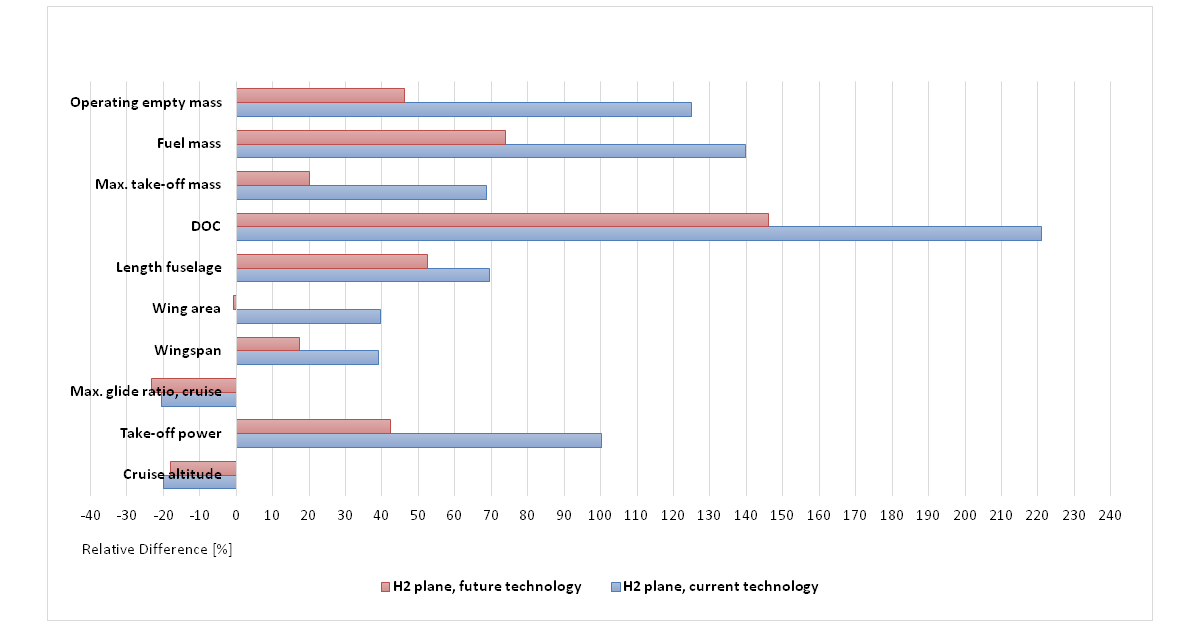
Passenger Aircraft towards Zero Emission with Hydrogen and Fuel Cells
Project
Autor: Martin Gollnow
Date: 2022-11-16
Supervisor: Dieter Scholz
Abstract
Purpose – This project evaluates the feasibility of passenger aircraft designed for Top Level Aircraft Requirements (TLAR) of the Airbus A320 using liquid hydrogen (LH2) and fuel cells to achieve "zero emissions". --- Methodology – An existing preliminary sizing tool for jet and propeller passenger aircraft (CS-25) is modified to include all elements for LH2 storage and fuel cell integration including electric motors and heat exchangers. Current and possible future technology parameters are determined from a literature review. --- Findings – The first reference aircraft is the redesign of the A320. The second reference aircraft is a possible turboprop version of the A320 with a cruise Mach number of only 0.65. The turboprop version shows a fuel mass and Direct Operating Costs (DOC) of only 66.1% and 86.5% respectively. Related to the A320 redesign, the fuel cell aircraft has fuel energy and DOC higher by 140% and 221% based on current technology parameters. If plausible future technology parameters are considered, the same values are 74% and 146%. These results show that a fuel cell passenger aircraft is unfeasible with current technology and remains unlikely with future technology. Water emissions can neither be avoided by water storage in flight nor by discarding the water in flight in form of ice cubes. --- Research Limitations – The impact of liquid water emissions during flight into the atmosphere needs to be investigated further, but seems not to be of major impact according to a recent publication. --- Practical Implications – The new preliminary sizing tool for fuel cell passenger aircraft is made available and can be used for further studies. --- Social Implications – So far large fuel cell passenger aircraft were seen as a possible solution to aviation's environmental problems. The general feasibility, energy requirements, environ-mental and economic impact of hydrogen-electric aircraft can now be discussed by the public. --- Originality – It seems, there is so far no preliminary aircraft sizing tool for hydrogen-electric aircraft publicly available.
Download full text
 TextGollnow.pdf
Size: 4.8M
TextGollnow.pdf
Size: 4.8M
URN, the Persistent Identifier (from the German National Library) to quote this Landing Page:
https://nbn-resolving.org/urn:nbn:de:gbv:18302-aero2022-11-16.010 
Entries into
- the German National Library (https://www.dnb.de),
- the Repository of Leibniz University Hannover (https://www.repo.uni-hannover.de) for the DOI,
- and the Internet Archive
will come later.
Associated research data: https://doi.org/10.7910/DVN/CURS1U

Comparison of the A320 with a new A320 powered with liquid hydrogen (LH2), fuel cells, and electric motors.
Results from preliminary sizing for two technology scenarios (current and future).
LAST UPDATE: 09 October 2023
AUTHOR: Prof. Dr. Scholz
IMPRESSUM (PDF)

 Prof. Dr. Scholz
Prof. Dr. Scholz
 Aircraft Design and Systems Group (AERO)
Aircraft Design and Systems Group (AERO)
 Aeronautical Engineering
Aeronautical Engineering
 Department of Automotive and Aeronautical Engineering
Department of Automotive and Aeronautical Engineering
 Faculty of Engineering and Computer Science
Faculty of Engineering and Computer Science
 Hamburg University of Applied Sciences
Hamburg University of Applied Sciences


 TextGollnow.pdf
Size: 4.8M
TextGollnow.pdf
Size: 4.8M


 Prof. Dr. Scholz
Prof. Dr. Scholz
 Aircraft Design and Systems Group (AERO)
Aircraft Design and Systems Group (AERO)
 Aeronautical Engineering
Aeronautical Engineering
 Department of Automotive and Aeronautical Engineering
Department of Automotive and Aeronautical Engineering
 Faculty of Engineering and Computer Science
Faculty of Engineering and Computer Science
 Hamburg University of Applied Sciences
Hamburg University of Applied Sciences